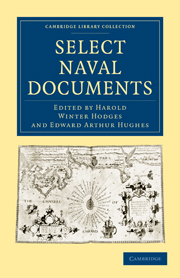Book contents
- Frontmatter
- Preface
- Contents
- LIST OF PLATES
- ILLUSTRATIONS IN THE TEXT
- ABBREVIATIONS
- HENRY VIII
- ELIZABETH
- JAMES I AND CHARLES I
- THE COMMONWEALTH AND PROTECTORATE
- THE RESTORATION NAVY
- WILLIAM III AND ANNE
- THE PEACE PERIOD AND NEED FOR REFORM
- WAR OF AMERICAN INDEPENDENCE, 1778–1783
- REVOLUTIONARY AND NAPOLEONIC WARS
- INDEX
HENRY VIII
Published online by Cambridge University Press: 07 September 2010
- Frontmatter
- Preface
- Contents
- LIST OF PLATES
- ILLUSTRATIONS IN THE TEXT
- ABBREVIATIONS
- HENRY VIII
- ELIZABETH
- JAMES I AND CHARLES I
- THE COMMONWEALTH AND PROTECTORATE
- THE RESTORATION NAVY
- WILLIAM III AND ANNE
- THE PEACE PERIOD AND NEED FOR REFORM
- WAR OF AMERICAN INDEPENDENCE, 1778–1783
- REVOLUTIONARY AND NAPOLEONIC WARS
- INDEX
Summary
We choose this reign as our starting-point, not because it is the beginning of English naval history, but because Henry VIII originated a new epoch—that of the broadside sailing ship. The two following lists give the armament of the Sovereign in 1497 and in 1509, when she was rebuilt. Before the time of Henry VIII, English warships were armed with a large number of small breech-loading guns, meant to sweep the enemy's deck as a preliminary to capturing him by boarding, and therefore carried high; while their own crews were protected from the enemy's fire by many-storied fore- and stern-castles, in which most of the guns were mounted, the rest being placed in the waist. Retaining the breech-loaders as a secondary armament, Henry VIII introduced a small number of heavy guns, which could penetrate the hull of an enemy, and which would have to be carried on a lower gun-deck. This is the germ of the revolution which converted the warship from a transport, to be attacked and defended by soldiers, into a gun-carriage or floating battery.
The changes in armament involved changes in ship-construction. The old ‘round-ship,’ besides being top-heavy, was only twice as long as she was broad, and was therefore very slow. Importing Italian ship-wrights, accustomed to build ‘galleons’ with a length of three times their beam, Henry experimented throughout his reign with a view to building ships which should be more seaworthy, speedier, and better gun-platforms. […]
- Type
- Chapter
- Information
- Select Naval Documents , pp. 1 - 7Publisher: Cambridge University PressPrint publication year: 2009First published in: 1922
- 1
- Cited by



